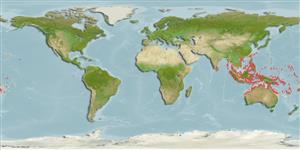Environment: milieu / climate zone / depth range / distribution range
Écologie
marin récifal; profondeur 1 - 20 m (Ref. 90102). Tropical; 27°N - 27°S, 28°E - 133°W (Ref. 74933)
Indo-Pacific: known from the Red Sea, Indian Ocean (except the Seychelles, Chagos Archipelago, Cargados Carajos, Mauritius and Rodrigues), north to Japan and south to Australia; throughout the West Pacific to the Tonga Islands, Samoa, Phoenix and Marshall Islands.
Taille / Poids / Âge
Maturity: Lm ? range ? - ? cm
Max length : 11.2 cm TL mâle / non sexé; (Ref. 90102)
Description synthétique
Morphologie | Morphométrie
Épines dorsales (Total): 8; Rayons mous dorsaux (Total): 9; Épines anales 2; Rayons mous anaux: 8.
Common in reef flats and shallow lagoons, but hiding by day within Acropora thickets and other corals, as well as in holes and crevices and emerging at night to forage on free-swimming invertebrates (Ref. 1602). Also found in sheltered seaward slopes in 1-20 m (Ref 90102). Feeds on small fishes and benthic invertebrates (e.g. shrimps - alpheids and penaieds; isopods, copepods, crab larvae, polychaete worms); relatively close to cover, within about 1-2 m (Ref. 11890).
Life cycle and mating behavior
Maturité | Reproduction | Frai | Œufs | Fécondité | Larves
Mouthbrooders (Ref. 240). Distinct pairing during courtship and spawning (Ref. 205).
Nakabo, T., 2002. Fishes of Japan with pictorial keys to the species, English edition I. Tokai University Press, Japan, pp v-866. (Ref. 41299)
Statut dans la liste rouge de l'IUCN (Ref. 130435)
Menace pour l'homme
Harmless
Utilisations par l'homme
Plus d'informations
RéférencesAquacultureProfil d'aquacultureSouchesGénétiqueElectrophoresesHéritabilitéPathologiesTraitementNutrientsMass conversion
Outils
Articles particuliers
Télécharger en XML
Sources Internet
Estimates based on models
Preferred temperature (Ref.
123201): 25.7 - 29.3, mean 28.7 °C (based on 2182 cells).
Phylogenetic diversity index (Ref.
82804): PD
50 = 0.5020 [Uniqueness, from 0.5 = low to 2.0 = high].
Bayesian length-weight: a=0.01698 (0.01020 - 0.02828), b=2.97 (2.83 - 3.11), in cm total length, based on LWR estimates for this species & (Sub)family-body (Ref.
93245).
Niveau trophique (Ref.
69278): 3.3 ±0.2 se; based on diet studies.
Résilience (Ref.
120179): Haut, temps minimum de doublement de population inférieur à 15 mois (Preliminary K or Fecundity.).
Fishing Vulnerability (Ref.
59153): Low vulnerability (10 of 100).
Nutrients (Ref.
124155): Calcium = 138 [71, 220] mg/100g; Iron = 0.953 [0.557, 1.629] mg/100g; Protein = 18.6 [17.4, 19.8] %; Omega3 = 0.12 [0.07, 0.20] g/100g; Selenium = 28.6 [15.1, 55.2] μg/100g; VitaminA = 55.8 [16.2, 190.5] μg/100g; Zinc = 1.69 [1.11, 2.49] mg/100g (wet weight);
